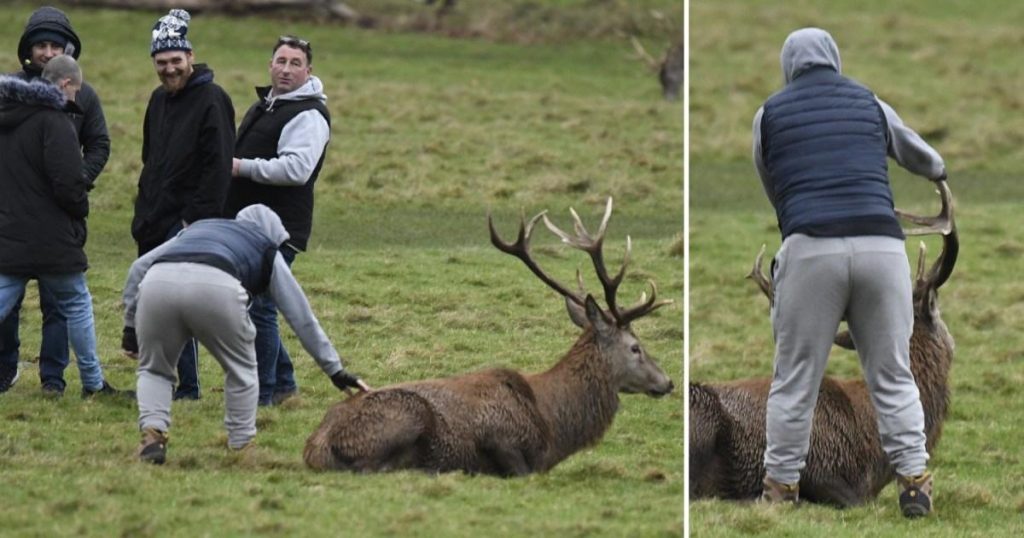Paragraph 1: The Incident
A disturbing incident of animal cruelty unfolded in Wollaton Park, Nottingham, where a group of young men were observed harassing a wild stag. Wildlife photographer Chris Golightly captured the unsettling scene, documenting the trio as they approached the resting animal. Clad in casual attire—hoodies, gilets, and tracksuit bottoms—the men proceeded to yank the stag’s antlers, shake its head, and slap its rump. Ms. Golightly, witnessing the event from a distance, immediately sought out a park ranger to report the behavior and present photographic evidence. Unfortunately, the perpetrators fled the scene before authorities could confront them. Nottingham Police are now investigating the incident, adding to a growing concern over increasing reports of “deer pestering” within the park.
Paragraph 2: Witness Account and Public Outcry
Ms. Golightly expressed her horror at the men’s actions, characterizing their behavior as bullying and cruelty. She recounted her initial observation of the group approaching the solitary stag before escalating their interaction to physical harassment. Her swift action in seeking park rangers demonstrated her commitment to protecting the park’s wildlife. The incident sparked public outcry and renewed calls for respecting the animals’ space. Langbein Wildlife, a conservation organization, shared the incident on social media, denouncing the reckless cruelty and commending Ms. Golightly for bringing the issue to light. They emphasized the vulnerability of stags during this time of year, exhausted after the rutting season, and stressed the importance of avoiding unnecessary disturbance.
Paragraph 3: The Vulnerability of Stags and the Need for Respect
Langbein Wildlife’s statement highlighted the precarious state of stags in the post-rutting season. Having expended significant energy during the mating period, these animals often seek refuge in parks, resting to recover. Their depleted condition makes them less likely to react to human intrusion, creating a deceptive appearance of placidity. This vulnerability, however, necessitates even greater respect and distance from human interaction. Disturbing these exhausted animals further compromises their recovery and adds unnecessary stress. The incident underscored the need for public education and awareness about appropriate wildlife interaction, emphasizing observation over interference.
Paragraph 4: Wollaton Park and its Significance
Wollaton Park, the setting of this unfortunate incident, is a significant landmark in Nottingham. It encompasses not only expansive green spaces and a dedicated deer park but also houses Wollaton Hall, an Elizabethan mansion that serves as the Nottingham Natural History Museum. The presence of such varied natural and historical elements within the park underscores its importance as a community asset. The incident of deer harassment tarnishes the reputation of this treasured public space and raises questions about how to better protect the wildlife that calls it home. Balancing public access with wildlife preservation emerges as a key challenge in managing this unique environment.
Paragraph 5: The Broader Context of Wildlife Harassment
This incident is not an isolated occurrence but reflects a broader societal issue of wildlife harassment. The seemingly innocuous actions of approaching, touching, or feeding wild animals can have serious repercussions, disrupting their natural behaviors and potentially leading to habituation, which can increase their vulnerability to human conflict and predation. Furthermore, deliberate acts of cruelty, such as those witnessed in Wollaton Park, inflict both physical and psychological harm on these creatures. It is crucial for society to recognize that wild animals deserve respect and space, and that human interaction should prioritize their well-being.
Paragraph 6: The Call for Action and Education
The incident at Wollaton Park serves as a stark reminder of the importance of responsible wildlife interaction. It necessitates a multifaceted approach that combines increased surveillance and enforcement with public education campaigns. Clear signage within parks should communicate appropriate behavior around wildlife, emphasizing the importance of maintaining a safe distance and refraining from any form of harassment. Educating the public about the potential consequences of their actions, both for the animals and for themselves, is essential. Furthermore, fostering a sense of shared responsibility for protecting these creatures within our shared spaces is crucial for ensuring their long-term survival and maintaining the integrity of our natural environment. By promoting respectful co-existence, we can safeguard these valuable resources for future generations.




